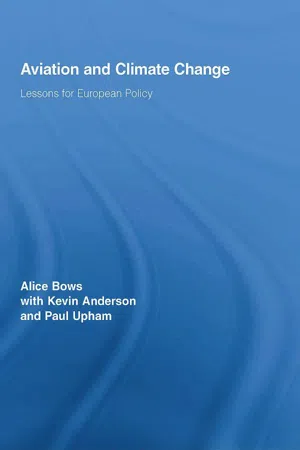
Aviation and Climate Change
Lessons for European Policy
- 14 pages
- English
- ePUB (mobile friendly)
- Available on iOS & Android
About this book
It is generally accepted – the US administration excepted - that the emissions reduction targets agreed in the Kyoto Protocol are only the beginning of what needs to be achieved in international climate negotiations. While studies suggest that major emission reductions by industrialized countries can be achieved at low economic cost, both these and early reductions by developing countries are inevitably a major political challenge.
This book focuses on European policy toward climate change, specifically its ramifications for the aviation industry. With air travel predicted to grow enormously in the coming years, the issue of climate change is hugely topical for this important industry.
Accessible to students, academics and practioners, this book is useful reading for all those with an interest in climate change, the aviation industry, or both.
Frequently asked questions
- Essential is ideal for learners and professionals who enjoy exploring a wide range of subjects. Access the Essential Library with 800,000+ trusted titles and best-sellers across business, personal growth, and the humanities. Includes unlimited reading time and Standard Read Aloud voice.
- Complete: Perfect for advanced learners and researchers needing full, unrestricted access. Unlock 1.4M+ books across hundreds of subjects, including academic and specialized titles. The Complete Plan also includes advanced features like Premium Read Aloud and Research Assistant.
Please note we cannot support devices running on iOS 13 and Android 7 or earlier. Learn more about using the app.
Information
Table of contents
- Routledge Studies in Physical Geography and Environment
- Contents
- Figures
- Tables
- Acknowledgments
- 1 Flying into Heavy Weather
- 2 Aviation
- 3 Climate Change and Cumulative Emissions
- 4 Opportunities for Aviation
- 5 Climate and Aviation Policy
- 6 Comparative Assessment
- 7 Aviation in the Wider Energy Context
- 8 Conclusion
- Notes
- Bibliography
- Index